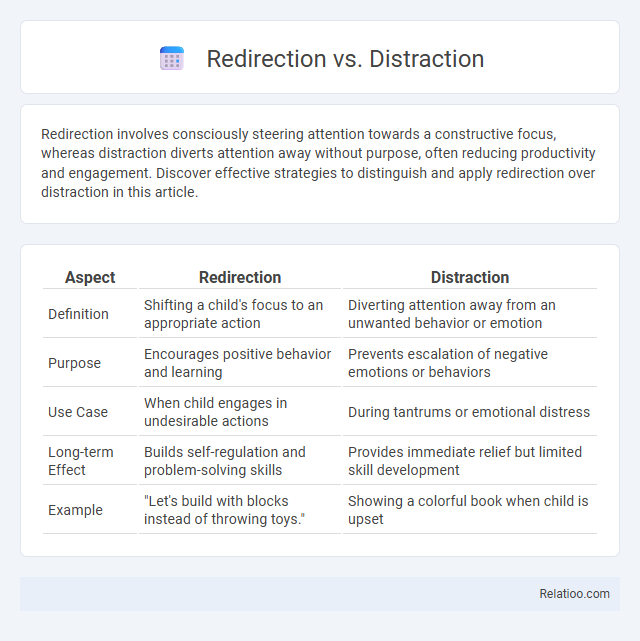Redirection involves consciously steering attention towards a constructive focus, whereas distraction diverts attention away without purpose, often reducing productivity and engagement. Discover effective strategies to distinguish and apply redirection over distraction in this article.
Table of Comparison
| Aspect | Redirection | Distraction |
|---|---|---|
| Definition | Shifting a child's focus to an appropriate action | Diverting attention away from an unwanted behavior or emotion |
| Purpose | Encourages positive behavior and learning | Prevents escalation of negative emotions or behaviors |
| Use Case | When child engages in undesirable actions | During tantrums or emotional distress |
| Long-term Effect | Builds self-regulation and problem-solving skills | Provides immediate relief but limited skill development |
| Example | "Let's build with blocks instead of throwing toys." | Showing a colorful book when child is upset |
Understanding Redirection and Distraction
Redirection involves guiding attention or behavior from an undesired focus to a more appropriate or positive alternative, often used in behavioral therapy and conflict resolution. Distraction entails diverting attention temporarily from a problem or discomfort to reduce negative emotions or prevent escalation, commonly applied in pain management and anxiety reduction. Understanding redirection emphasizes purposeful behavior change, whereas distraction prioritizes momentary relief from distressing stimuli.
Defining Redirection in Behavioral Management
Redirection in behavioral management involves guiding Your attention or actions away from undesirable behavior toward a more appropriate alternative, effectively preventing escalation. Unlike distraction, which diverts attention temporarily without addressing the underlying cause, redirection actively promotes positive behavior change and supports emotional regulation. Clear definition and application of redirection techniques enhance your ability to manage challenging behaviors efficiently and compassionately.
What is Distraction? Key Characteristics
Distraction is a cognitive process where attention is diverted from a primary task or focus due to an external or internal stimulus, leading to reduced concentration and performance. Key characteristics of distraction include involuntary attention shifts, susceptibility to both sensory inputs and emotional triggers, and a decreased ability to complete tasks efficiently. Your ability to manage distractions is crucial for maintaining productivity and mental clarity in various environments.
Redirection vs Distraction: Core Differences
Redirection involves guiding your attention or behavior towards a more appropriate or beneficial focus, while distraction diverts your attention away from the primary task or goal, often causing decreased productivity or engagement. The core difference lies in intent and outcome: redirection aims to refocus and improve your concentration, whereas distraction typically results in loss of focus and reduced efficiency. Understanding these distinctions helps you manage your attention effectively to achieve better results.
Situations Best Suited for Redirection
Redirection is best suited for situations where Your focus needs to shift from a negative behavior to a positive or neutral activity, such as calming an agitated child or preventing conflicts in social interactions. Unlike distraction, which briefly diverts attention without addressing the underlying cause, redirection encourages engagement with alternative tasks that satisfy the original need. Using redirection effectively helps promote emotional regulation and constructive behavior changes in various settings like parenting, therapy, and education.
When to Use Distraction Effectively
Distraction is most effective when immediate emotional regulation is needed, such as during moments of acute stress or frustration, providing a temporary shift away from distressing thoughts. Use distraction techniques like engaging in a hobby, physical activity, or sensory experiences when redirecting focus is not feasible or may escalate emotions. Unlike redirection, which guides attention toward positive alternatives, distraction serves as a short-term coping strategy to diffuse overwhelming emotions before reengaging with the issue.
Psychological Impact of Redirection
Redirection in psychology involves guiding Your attention from negative or harmful thoughts toward positive or neutral stimuli, fostering emotional regulation and reducing distress. Unlike distraction, which temporarily shifts focus away without addressing underlying issues, redirection engages cognitive processes to enhance coping skills and promote long-term psychological resilience. Repetition of redirection techniques can rewire neural pathways, supporting sustained mental well-being and adaptive behavior.
The Role of Distraction in Emotional Regulation
Distraction serves as a powerful tool in emotional regulation by shifting Your attention away from distressing stimuli, reducing the intensity of negative emotions. Unlike redirection, which alters the focus to a different thought or activity, distraction temporarily suspends emotional processing, enabling immediate relief from overwhelming feelings. Effective use of distraction can enhance emotional resilience and prevent maladaptive responses during stressful situations.
Redirection and Distraction: Pros and Cons
Redirection and distraction are two distinct techniques used to manage attention, where redirection involves guiding Your focus from negative stimuli to positive or neutral alternatives, helping to address underlying issues effectively, while distraction simply diverts attention temporarily without resolving the root cause. Redirection's pros include fostering problem-solving and emotional regulation, but it can be challenging if the underlying issue is not fully addressed; distraction offers immediate relief and stress reduction but may lead to avoidance or increased frustration over time. Understanding these pros and cons helps in choosing the appropriate strategy for improving mental well-being and behavioral outcomes.
Choosing the Right Approach: Expert Recommendations
Choosing the right approach between redirection, distraction, and redirection depends on your specific situation and goals. Experts recommend evaluating the individual's emotional state, context, and objectives to determine whether gently steering attention (redirection) or shifting focus to an unrelated activity (distraction) will be more effective. Your ability to assess these factors ensures the strategy supports positive outcomes and minimizes frustration.

Infographic: Redirection vs Distraction
 relatioo.com
relatioo.com